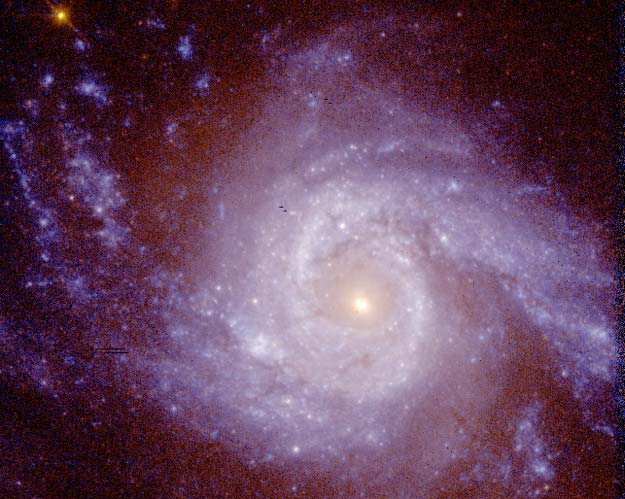Explanation: Why is NGC 3310 bursting with young stars? The brightest of these new stars are so hot that they light up this spiral galaxy not only in blue light, but in light so blue humans can't see it: ultraviolet. The Hubble Space Telescope took the above photograph in different bands of ultraviolet light. Speculation holds that NGC 3310 collided with one of its own dwarf companion galaxies only about 50 million years previously. This merger sent density waves rippling around the spiral disk, causing many gas clouds to condense into star forming regions. Imaging nearby galaxies in ultraviolet light allows astronomers to better understand the images of distant highly redshifted galaxies in visible light, and so to understand why many of these distant galaxies appear relatively fragmented. The unusually smooth NGC 3310 spans over 20 thousand light years and lies about 50 million light years away towards the constellation of Ursa Major.
1999 2000 2001 2002 2003 2004 2005 2006 2007 2008 2009 2010 2011 2012 2013 2014 2015 2016 2017 2018 2019 2020 2021 2022 2023 2024 2025 |
Yanvar' Fevral' Mart Aprel' Mai Iyun' Iyul' Avgust Sentyabr' Oktyabr' Noyabr' Dekabr' |
NASA Web Site Statements, Warnings, and Disclaimers
NASA Official: Jay Norris. Specific rights apply.
A service of: LHEA at NASA / GSFC
& Michigan Tech. U.
|
Publikacii s klyuchevymi slovami:
spiral'naya galaktika - Ul'trafioletovoe izluchenie - spiral galaxy - ultraviolet
Publikacii so slovami: spiral'naya galaktika - Ul'trafioletovoe izluchenie - spiral galaxy - ultraviolet | |
Sm. takzhe:
Vse publikacii na tu zhe temu >> | |
